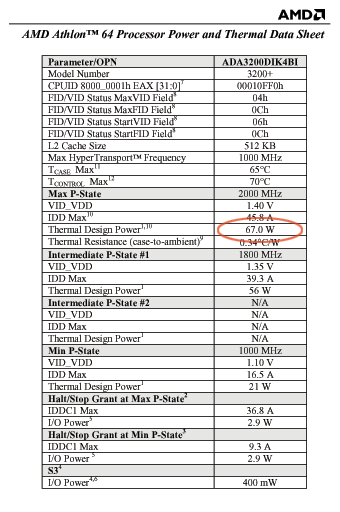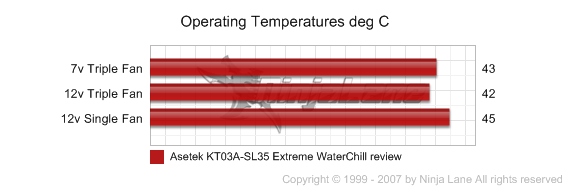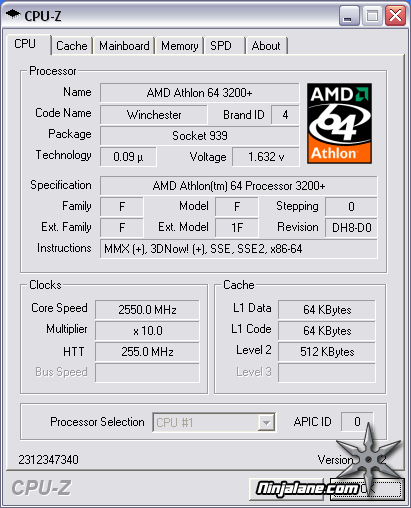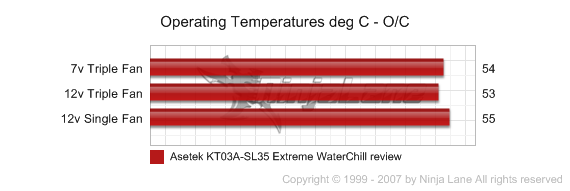After careful consideration I have decided to transfer all hardware review activities to a new domain. I purchased Hardwareasylum.com in 2012 and have been working hard to build a new and improved Ninjalane on that domain. If you are reading this you have reached one of the archived articles, news, projects and/or reviews that were left behind during the site migration.
Please update your bookmarks and be sure to visit the new and improved Ninjalane at Hardwareasylum.com
Asetek KT03A-SL35 Extreme WaterChill review
Author: Dennis Garcia
Published: Thursday, March 17, 2005
Benchmarks
The asetek KT03A-SL35 is designed for all types of processors. Here is an overview of the system and testing methodology.
The system as it was tested
Soltek SL-K8TPro-939
Athlon64 3200+ 512KB L2 Cache 939 ADA3200DIK4BI
asetek WaterChill KT03A-SL35
- Antarctica CPU Block
- asetek Waterchill Northbridge cooler
CPUCool was used to obtain and record system temperature information and a game of UT2004 provided the processor usage.
Athlon64 3200+ 512KB L2 Cache 939 ADA3200DIK4BI
asetek WaterChill KT03A-SL35
- Antarctica CPU Block
- asetek Waterchill Northbridge cooler
CPUCool was used to obtain and record system temperature information and a game of UT2004 provided the processor usage.

Editors note: Even though the Windows XP task manager reported 100% processor usage we could never attain a 100% of the rated heat output as documented by AMD (see below)
when using UT2004 as a basis for that heat production. Knowing this the game was played until the maximum temperature was attainted and stabilized, or when the round was over.
Other things to consider when judging software induced heat output.
a) Clock throttling by the processor at high temperatures.
b) Normal software isn't designed to produce maximum heat output.
c) Variances of cooling temperature.
d) Variances in CPU load.
e) Inaccuracies in thermal diode readouts.
Of course the list goes on..
My testing methodology is aimed to provide a real world look into this heatsink given the test system provided.
a) Clock throttling by the processor at high temperatures.
b) Normal software isn't designed to produce maximum heat output.
c) Variances of cooling temperature.
d) Variances in CPU load.
e) Inaccuracies in thermal diode readouts.
Of course the list goes on..
My testing methodology is aimed to provide a real world look into this heatsink given the test system provided.
Default

A C/W rating can quickly be calculated using this formula.
C/W = (CPU temp - Ambient temp)/(Variance(%) * CPU Watts)
Allowed variance for this test = 75%
CPU Watts = 67W
0.36 C/W = (42C - 24C)/(.75(67W))
C/W = (CPU temp - Ambient temp)/(Variance(%) * CPU Watts)
Allowed variance for this test = 75%
CPU Watts = 67W
0.36 C/W = (42C - 24C)/(.75(67W))
Overclocked


To calculate a new C/W rating for this test we will need to factor in the increased processor
wattage. The formula and constants for this are listed below.
ocC/W = dCPU Watts * (ocMhz / dMhz) * (ocVcore / dVcore)2
ocMhz = 2550
dMhz = 2000
ocVcore = 1.65
dVcore = 1.36
The variance still applies for our C/W calcuation
Allowed variance for this test = 75%
CPU Watts = W
0.31 C/W = (53C - 24C)/(.75(125.6W))
ocC/W = dCPU Watts * (ocMhz / dMhz) * (ocVcore / dVcore)2
ocMhz = 2550
dMhz = 2000
ocVcore = 1.65
dVcore = 1.36
The variance still applies for our C/W calcuation
Allowed variance for this test = 75%
CPU Watts = W
0.31 C/W = (53C - 24C)/(.75(125.6W))
Benchmark Conclusion
With just about every cooling system there are limits to how much heat it can consume and dissipate. The single fan option had the highest temp, as expected, and the triple fan version running at 12v had the lowest temp. However given the variance and inaccuracies outlined above it is pretty safe to say that the asetek KT03A is dissipating all it can but we couldn't pump enough heat in to really make a difference. From an enthusiast standpoint this exactly what you need from a high-end watercooler.
Keep in mind these calculations are provided for demonstration purposes only and may not reflect the actual lab tested C/W rating, but I think I'm close
Keep in mind these calculations are provided for demonstration purposes only and may not reflect the actual lab tested C/W rating, but I think I'm close

